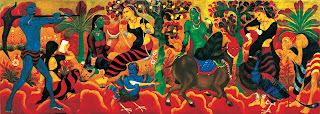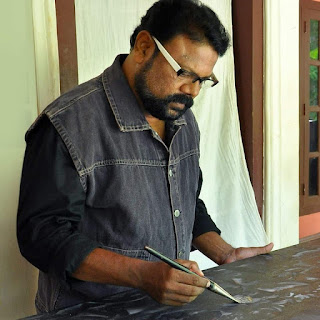Truly international artists have their identities made fluid
by the circumstances that make them international. Attaching their identity to
a particular country often limits them to be provincial artists with
international repute. Even if one does not travel quite often all over the
world in order to make their identities physically fluid, the museums and
galleries would overwork to make sure that their artists’ identities are fluid
enough to transcend the geographical as well as political borders. Being
international is something related to assuming an identity that keeps shifting
according to the needs of an exhibition or a set of works of art or even a
particular issues handled by the artist. An artist hailing from the white world
(even if he/she is black complexion-wise) automatically gets this fluid
identity by participating in international museum shows and art fairs, and also
by getting featured in a few influential magazines and journals. However, we
know that this fluid identity, it being an artificial construct does not make
them international in a political sense because they absolutely lack the ground
level realities of politics of their host countries in a given time.
So what do they talk when they talk about the international
issues that pester the conscience of the world and the physical realities of
the countries that are at the grip of the conglomerations of corporations that
seek financial profitability through various anti-humanistic activities?
International artists are supposed to comment on them if they really are
expected to touch the core of the ongoing issues of the world. But often they
do not go into particulars but touch upon the larger abstractions made out of
issues that look like affecting one and all. But in fact such issues, for
instance migration, refugee problems, epidemics, terrorism, war, drug dealing,
women’s liberation, liberation of the oppressed people or people from the war
torn areas, issues of the different genders and so on are not affecting
everyone in the world; they are limited to pockets but are lionized to make
them really global issues so that a series of global forces could get involved
in the minute areas pertaining to all these problems and stake their claim.
That means, such problems are problems made to be believed as problems
affecting us and they remain as reminders of the possibility of turning any
part of the world for or against such problems. That’s why many international
artists do not touch up on the issues that are local but crucial instead they
touch upon the larger abstraction, aforementioned, so that their works could
become commentaries of/on it which could be used, ironically, for or against
the same issues.
(Anish Kapoor's painting at the Lisson Gallery)
Slavoj Zizek, the famous polemic theoretician, recently
opined in one of his speeches that the internationally artists who exhibit in
great museums and galleries pretend to be critical of the global state of
affairs but in fact participate in the supportive discourse of the dominant
that is being helped by the cultural discourses created by the museums and
galleries, often supported by the same forces that support the capitalist
hegemonic forces that rule most of the countries in the world. So the
abstractions are easier for the artists when it comes to their international
presence. They can comment on anything. Make extremely out of the context
comment on the issues and in fact get away with the consequences of their statements.
Why so, because most of their comments are taken for their topicality and entertainment
value and the performing aspect of their statement often make a few headlines
only to be dead within few hours of their appearance. For example, when the
flow of refugees from the war-torn Syria started affecting the social fabric of
Europe, Ai Wei Wei and Anish Kapoor walked the London streets with heavy
blanket on their shoulders exemplifying the act as the reminder of the
legendary exodus led by Moses, making the citizens of the world think that by origin
everyone was a refugee on the face of the earth. Sooner than later it was found
that both the artists were having their solo exhibitions in London and they got
enough eyeballs and the eye of a storm so that even the media could overlook
the real refugee issue and focus on the softer performativity of the artist,
for the time being.
Anish Kapoor’s identity, as I mentioned before is a fluid identity
which helps him to comment on any problem in any part of the world. When India
was booming in terms of art market during the first decade of the 21st
century, Anish Kapoor had suddenly found out his Indian roots and he was dubbed
as an Indian born British artist. But once the market days were over and when
he was invited to the KMB’s second edition, it was not his Indian roots that
grabbed attention of the press and people but his international identity as a
British citizen, who was capable of churning the world with his opinion and
work of art. True to his nature and intelligence, and also culture, he brought
one of his works and ingeniously re-enacted it inside a gallery at the KMB
venue where the whirlpool that he created was seen as the emblematic
representation of the world today, all in a chaos; and the hope that from the
chaos there arose order. And Anish Kapoor having a great back history of
sculptural and glass surface abstractions, the whirlpool could have also been
given an extremely abstract description that often helps people to relate
simply with the artist. Many people see it as an interesting form, a very
clever one making each one wonder why he/she wouldn’t think of it before Anish
Kapoor did.
(Anish Kapoor's works at the Lisson Gallery)
Today, Anish Kapoor is having his seventeenth solo
exhibition at the Lisson Gallery in London (their Bell Street premises). Kapoor
has presented his paintings as well as some sculptural forms. It must be a warming
up show because some of his important solo exhibitions are to be coming up in
China and elsewhere in the world. So here is a talking point show so that it
could lead to the larger shows with more worldly wisdom coming from Anish
Kapoor. Kapoor is not really ‘painter painter’ type though he has been painting.
Many sculptors often claim that they have always painted on the side.
Giocometti’s paintings, in this sense are really worth remembering. So are the
drawings and paintings of Henry Moore and Barbara Hepworth. So Kapoor’s
paintings cannot be disputed as ‘those paintings’ that he did for the heck of
it. The ones that obviously bring the images of the American artist Philip
Guston in mind, seem to have a larger issue to discuss as explained by the
artist himself in a report published in the Art Newspaper. In this report he
says that it is all about the menstruation issue, of the bodily fluids, of a
place where the male dirt goes in and a life comes out. As far as Kapoor
previous works are concerned, the women’s bodily orifices could be seen abundantly
though none had the time or leisure to articulate them sole in those terms. But
here the artist himself insists that it could be read so. He does not intend
them to be erotic, but they have an erotic feel about them, a sort of fantasy
play where he expresses his own fear from the vagina dentate or vagina medusa,
if one allows me to say so.
This could be said an un-sanitized statement by Anish
Kapoor. He has not so been explicit while explaining his art. But he somehow
recognizes the fact that internationally menstruating women and the taboo
related to it are big issues that need a sort of addressing by one and all. But
only question is whether the feminists in the world would be amused by this
voluntary agency given to the issue by the world famous artist. Hardcore
feminists who are immersed in parity discourse, may not be interested to see
this artistic transgression with sympathy for they believe that the agency of
such issues should be held intact by the women themselves as they could voice
them much more experiential-ly than the males. The tyranny of experience debars
males from articulating the feminine experiences to certain extent. Having the identity
of an international artist, Anish Kapoor cannot remain silent on this taboo
either.
(An early work of Anish Kapoor)
Perhaps, the Lisson Gallery knows this artistic dilemma
better and their marketing tactics, they believe are to be neutral, artistic,
sanitized, non-polemical and abstract. Big Money wouldn’t like to get entangled
with issues like refugee problem, menstruation, malnutrition etc. They would
like to have a work of art that speaks everything in the highly sophisticated and
euphemistic terms. In the Press Release issued by the Lisson Gallery, not even
once the word menstruation is used. The whole matter is covered up in such way
which would have even contradicted Shakespeare had he been alive; he had said,
life is a tale told by an idiot, full of sound and fury, signifying nothing.
Lisson Gallery would correct him, it is full of sound and no fury, and
signifying more what eyes could see. Let me quote a few lines from the Press
Release: “Elsewhere an ovoid steel orifice, engulfed by a web of welded
metallic shards, encapsulates the brutal eroticism of the works in the show.
However, this is no easy seduction. Kapoor’s new works do not present us with a
symbolized sensuality, rather it is in the ineffable dark voids of these
generative forms that the artist creates a space we might intuit an as yet unknown
known.” In another paragraph it is
written, “….on the edge of figuration they seem to depict swollen and fecund
organs that ooze and leak from their dark interiors.” This is how the concrete
is made abstract by international artists and their galleries.






































